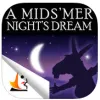Take a look inside 6 images
Shakespeare in Bits: A Midsummer Night's Dream
Pros: Side-by-side text and animations, as well as subtitles, help students connect the text and video; analyses make understanding the text easier.
Cons: Some students may rely on the scene summaries and other analyses instead of actually reading the play.
Bottom Line: Numerous supports, including cartoons, audio, and paraphrased passages, help students understand one of Shakespeare's most popular and most confusing comedies.
Teachers may opt to use this version of A Midsummer Night's Dream as the sole version of the text or as a support for students who have trouble understanding the more traditional version of the text. At times, highlighting the animation in certain scenes may help the class as a whole understand a confusing section. Scene summaries, character descriptions, and other analyses may prove useful when writing papers and completing projects related to the play.
Animated Shakespeare is what you will find in Shakespeare in Bits: A Midsummer Night's Dream. Scene by scene, students can watch animations that follow exactly the text of the comedy, seeing the text highlighted or in subtitles as characters speak and clicking on unfamiliar words to get definitions. Students who have trouble understanding the Bard's language will find that the other supports, such as scene synopsis, character profiles, and general analysis, help enhance their understanding of the play.
Reading Shakespeare can be a frustrating experience for many students. Those who struggle with reading and Shakespeare may see a light at the end of the tunnel when they encounter this version of A Midsummer Night's Dream. By placing the animations and text side by side, students do more than just watch a video version of the play. They connect the words directly with what's going on, helping them not only understand what's happening in this magical play, but also build an understanding of the language of Shakespeare.












